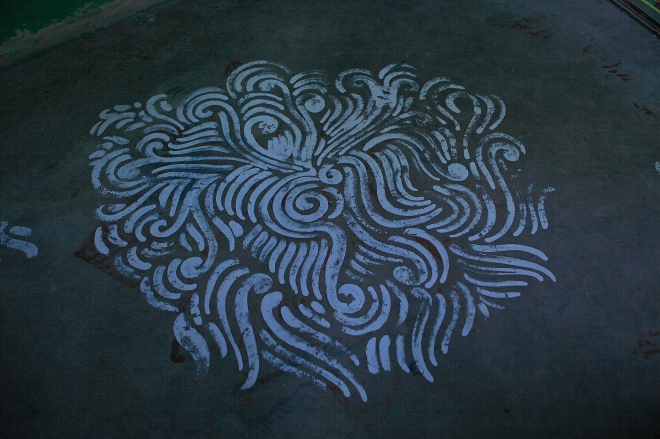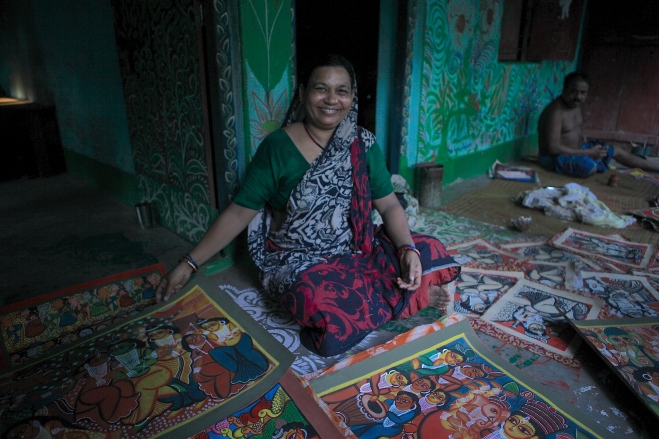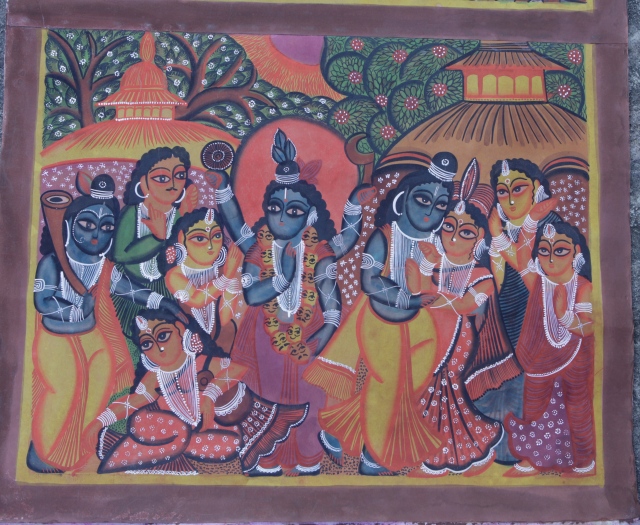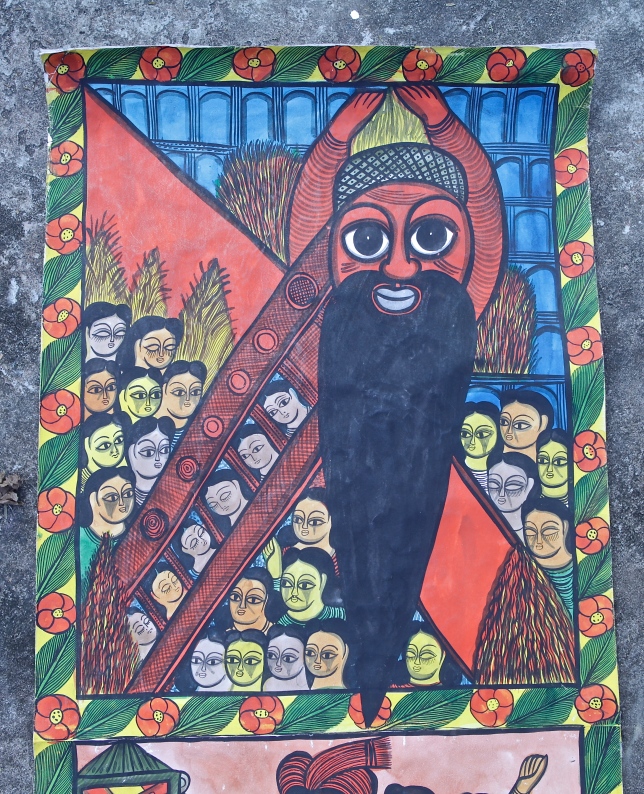Sharna Chitrakar
I asked Sanchayan Ghosh, lecturer in Fine Arts at Kala Bhavana, Santiniketan, his thoughts on Naya artists innovating with tradition regarding scroll imagery. Sanchayan suggested I look at Sharna Chitrakar’s work – he believed that as a mature artist she had been taking a creative approach to her work for some time, with both traditional and contemporary stories.
In Naya, I asked Sharna if I could look at her work. I could understand what Sanchayan had meant when he said she was on her own track regarding style. Sharna uses the soft vegetable colours to great effect, her images are refined and detailed. Sharna blends the Kalighat style of watercolor ‘shading’ with ornamentation and details found in Rajput miniatures. Sharna makes scrolls about stories from the Ramayana and Mahabharata epics and her fusion of these styles makes them visually very appealing. Developing her own style that caters well to Hindu sensibilities and tastes has helped Sharna to create a niche for herself in the competitive folk-art market, and her scrolls fetch high prices, on average around ten to twelve times more than scrolls by other established artists in the village.
Sharna Chitrakar, 2013, Krishna Lila, vegetable paint, paper, cloth, detail
I wanted to hear Sharna’s singing and to see her performing style. She allowed me to record her singing her version of the now famous 9/11 scroll. Sharna, Rani and other artists of Naya have been making Tsunami and 9/11 scrolls well beyond the years in which the events took place as such works which were written about by art theorists were then picked up by curators, and subsequently found a niche in the contemporary art market. As they have brought attention to the community, they continue to be good sellers with tourists. I saw scrolls of these two stories in small and large versions. Concerning structure and lyrics however the song of each story does not change although it may be vocally embellished in different ways according to the artist performing.
Sharna has a melodious, strong voice with a good deal of vibrato. It’s a voice that has refinement and smoothness and that makes it very different to the voices of Rani, Karuna and Susuma. Her voice could almost be said to polarize with the voice of Rani Chitrakar in the way that she reaches notes with little effort and is able to swell her voice without cracking.
Sharna has a lovely voice and sings the 9/11 song for me. When I sat with the translator to fit subtitles to the song, I was able to what Sanchayan had pointed out to me concerning Karuna Chitrakar’s performance of her Rabindranath Tagore scroll (see post Karuna Chitrakar). Sanchayan had said that parts of the image would not be able to be understood clearly if at all by a viewer, unless contextualised through a combination of song and gesture of the painter. I asked Sanchayan at the time if he was referring to a Bengali speaking audience, or a foreign audience. He had said that even a Bengali audience would have difficulty understanding the images without the song in combination with the gesture – the pointing of the finger (to the image). I found this interesting in context of communication across languages. Often I had found myself relying on miming and charades to communicate to people in Naya. Sharna’s concise and well placed gestures to pictures in her scroll suggested that barriers of language had been thought out and addressed by the Patuya Sangit tradition. This makes sense in light of the fact that it was not so long ago that these storytellers would have been travelling all over North and possibly Central India from village to village, to earn enough money to live on, and that they would have had to negotiate the way that dialect and over greater distances, the language in key ways would have altered every few kilometres.
I was also interested in how artists control the viewers progression through a scroll via performance. Whenever I watched a scroll being performed I found myself in the hands of the performer whose gestures guided my gaze through the painting, which was unfurled frame by frame or as required. It was highly effective, ensuring that the audience was taken through the story in an organised and concise manner which would ensure their grasp of the plot and understanding of key themes.
Images from Sharna’s 9/11 scroll, vegetable paints, paper, cloth. Photograph: Michal Glikson
On Sharna’s floor was a rangoli, a painted floor design that looks like a mandala. Rangolis are created, usually by the women of a family, on the doorsteps of their homes during a time of worship, or a special occasion or religious festival.
I didn’t ask Sharna what the rangoli signified but I photographed it because it looked different to any I had seen before. Sharna’s home was full of color and design. The inside walls as well as the outside ones of Sharna’s home were ornately painted with patterns and flowers, and her floors had different designs, such as the one below at the three doorways.

Rangoli in Sharna’s home, Naya. Photograph: Michal Glikson



Singing and storytelling with a staged unrolling of the scroll certainly shows the variety of ways such scrolls can be used to tell a story – as i said before it begs the use of music, video, closeups, storytelling – as you say the links to frames in film are clear. luv rod